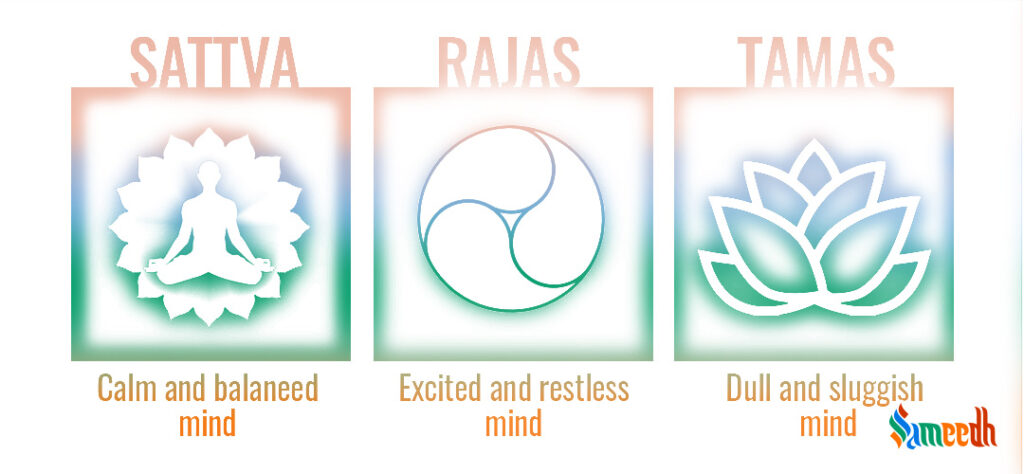In Hindu philosophy, particularly within the framework of Samkhya and Vedanta, the concept of the three gunas (qualities or modes) plays a fundamental role. The three gunas are intrinsic qualities that are believed to form the basis of all psychological, emotional, and physical aspects of existence.

Guna translates to quality or attribute from Sanskrit. Samakhya philosophy of Hinduism, which elaborates on reality, human behaviour, mentions the three Gunas; Sattva, Rajas and Tamas. These three are known to be present in every element or Tattva of nature including all living beings in various capacities. These are identified not only as characteristics but also as energy frequencies and states of consciousness. The three Gunas are ever present in the environment but the temperament of any being is determined by the most dominant Guna in their body. The quantity of these Gunas can be altered though through meditative, spiritual practices as well as routine lifestyle change of habits and food.
Sattva
Sattva essentially equates to purity. Honesty, harmony, intelligence, goodness, balance, satisfaction, knowledge and joy are its traits. Sattva is indeed the most desirable Guna which brings in positivity, peace and progress. It is an upward flow of energy. People with a dominant Sattva Guna are truthful, noble, calm and stable in life. They are free of ill practices and do not harbour negative emotions of sadness, jealousy, insecurity and anger. Natives with maximum Sattva are also known to be creative and achieve much success in life, not only materialistic but also at a spiritual level with the power of informed insights. It is the state of awakeness, where one is the most conscious. To increase the content of Sattva in the body, an individual can start Meditation and Yoga regularly by practising various asana and pranayamas, along with acquiring information on various topics to expose the brain to new possibilities. Consuming Sattvic Foods too can help immensely. Staying out of toxic surroundings, avoiding violence at all costs and steering away from negative indulgences too can be employed for a healthy balance between body and mind.
The last three days of Navratri, a nine day festival of goddesses, are associated with Sattva where goddess Sarwaswati is worshipped.
Rajas
Rajas is passion, activity, energy, stimulation and any movement. It is also considered as the state of dreaming or subconsciousness. Rajas is a hyperactive Guna and its high presence can make an individual overworked, anxious and stressed at times. Needs of attachment, desires of pleasure are ruled by Rajas. A person can exhibit qualities such as anger, restlessness, prolonged worry, fear, irritation but at the same time is over ambitious too. Dominance of Rajas indicates the quest to achieve and conquer goals, attain possessions and keep progressing materialistically. These people are observed to be obsessed with power and gain satisfaction from immediate gratification and dopamine hits. The three middle days of Navratri are influenced by Rajas and goddess Laxmi of wealth is prayed to during those days. Rajas is only required in small doses in the body. Avoid eating spicy or fried foods and drinking high amounts of caffeine to reduce Rajas along with practising mindfulness and concentration on spiritual growth.
Tamas
Tamas is recognized by darkness, laziness, inactivity and dullness. It is a downward flow of energy which induces lethargy in beings and is the total state of sleep or unconsciousness. The ones who are dominated by this Guna often feel unproductive, low on energy, depressed and drowsy. They lead an aimless life and are surrounded by dark thoughts which keep them from setting goals and working towards it. This Guna is believed to be unhealthy for a person’s growth and well being. It is crucial to decrease this Guna in the body by engaging in exercises and avoiding heavy oily foods, meat, alcohol etc.
The first three days of Navratri are attributed with Tamas and goddess Durga is worshipped during that time.
Sattva is deemed to be the finest Guna and the aim of life to reach liberation or Moksha can be achieved only when one is majorly governed by Sattva and not Rajas or Tamas.
The Bhagavad Gita, a revered Hindu scripture, discusses the concept of gunas in detail, particularly in Chapter 14. Lord Krishna explains to Arjuna how these gunas influence human behavior and how one can transcend them through spiritual knowledge and discipline.
